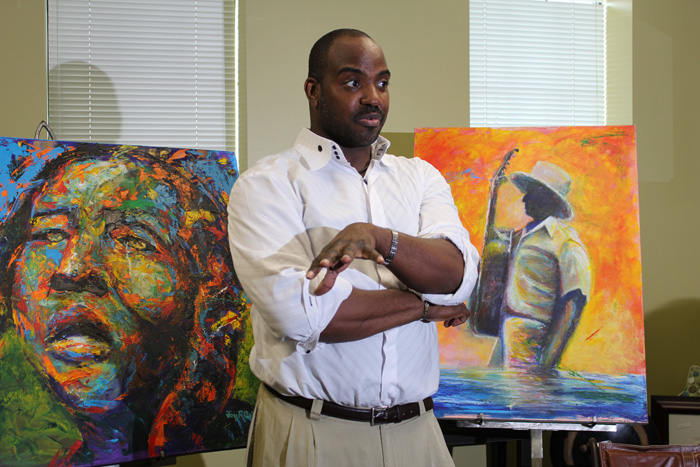Gaining Perspective East of the Anacostia River

My first week interning for the Smithsonian Folklife Festival ended with a trip out into "the field" to meet some of the people who will be sharing their life experiences, art, and knowledge with the public as part of the festival program Citified: Arts and Creativity East of the Anacostia River. It was a fitting conclusion to a week spent learning about what makes the neighborhoods East of the River unique, and writing short biographies, and questions to help acquaint the festival-goers with the creative minds of this community. I was finally able to see for myself why these neighborhoods were chosen to be presented at the 2012 festival.
Our first stop was at Adobe Design Center and Showroom, where artist Jay Coleman displays what he calls "arbitrary color portraits." Jay has painted portraits for Rosa Parks and several presidents of African countries, but I soon learned that he was much more than a portrait artist. He is also an educator and dedicates himself to special education through an innovative program in which he uses saltwater fish tanks as a means to teach kids with disabilities.
In addition to providing an alternative format for special education, his program also helps raise awareness of water conservation, and this theme makes its way back into Jay’s paintings. One portrait we saw was a silhouette of legendary folksinger Lead Belly walking through water. After spending some time with Jay, it was clear that creativity comes in many forms. Jay’s creativity manifests in different kinds of visual art, performance, and education.
Our next stop was Charles "Coco" Bayron’s Nu Flava Ink Tattooz, which is easy to miss on the main drag of Congress Heights. The red door is squeezed between other businesses and doesn’t offer any conspicuous sign for the unacquainted passerby. Perhaps that’s because Nu Flava Ink Tattooz operates more like a family than your typical business.
Upon entering, a staircase covered in a colorful graffiti mural leads to the waiting room where Vonnie, Coco’s wife, runs the check-in window. Tattoo "flash," or standard tattoo designs, along with helpful signs detailing business policies provide a backdrop to a surreal yet welcoming atmosphere. The smell of incense and the sound of the needle are at once calming and intimidating. After entering the artist’s workspace, however, all anxiety is assuaged by Coco’s soothing words spoken to his clients. He provides them with subtly engaging conversation as a continuous distraction from the sting of the needle while he creates works of art on a skin canvas. Coco, Vonnie, Coco’s business partner, Mike, and his clients all seemed like one big tattooed family.
Coco moved to Southeast D.C. from his life as a graffiti artist in New York City. Since establishing his business in Congress Heights, he has become a valuable part of the community. An inspirational mural he painted on the side of the building depicting President Barack Obama alongside Dr. Martin Luther King Jr. serves as a background for many family photos.
Although the front door says "No Minors," Coco is an inspiration and mentor to young aspiring artists in the neighborhood. He told us how kids will ask for his opinion of their most recent art works because they look up to him as a local professional artist. It’s no wonder kids take a liking to Coco; his gentle voice, endearing smile, and sincere eyes belie the tough-guy stereotype of tattoo artists. Nu Flava Ink Tattooz has definitely made its permanent mark on the Southeast D.C. community.
A trip east of the river would not be complete without a visit to "The Big Chair," a 19 ½- feet-high sculpture built in 1959 by the Bassett Furniture Company. This iconic piece of furniture is a reminder of Anacostia’s history and perseverance, and everyone we met that day talked fondly about the chair. The "Godfather of Go-go music," Chuck Brown, who passed away just a few weeks ago, was even allowed to pose on top of the chair for a photo. Many of the people we talked to in Southeast D.C. expressed great respect for Chuck Brown. Coco wore a shirt with his image, and Jay plans to involve festival-goers in a portrait of Chuck Brown. A musical tribute is also being planned as part of the Citified program at the festival.
Hearing what community members had to say and experiencing the environment in which they live and work helped me gain perspective on what it is we are trying to accomplish at this year’s festival. It will be a truly inspirational experience to see the many artists who represent the neighborhoods East of the Anacostia River come together this summer to celebrate and involve the public in their folklife.
Click on images to enlarge and view captions.








Jennie Terman is an intern with the 2012 Smithsonian Folklife Festival program Citified: Arts and Creativity East of the Anacostia River. She is a graduate student at the University of Maryland where she studies ethnomusicology and is a teaching assistant for The Impact of Music on Life.

